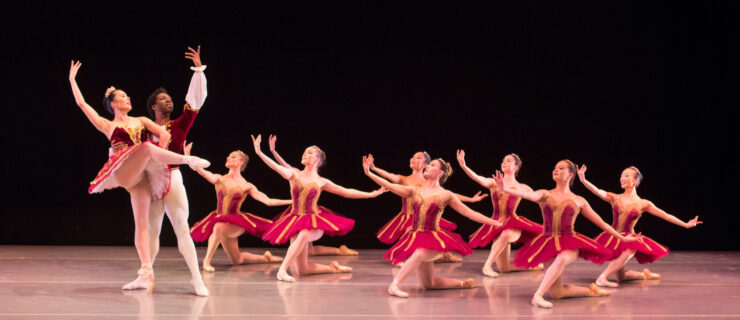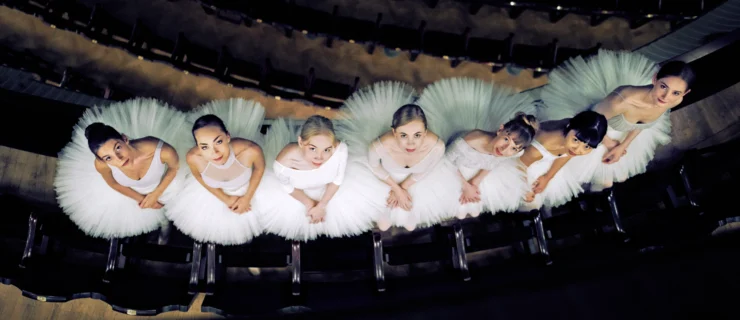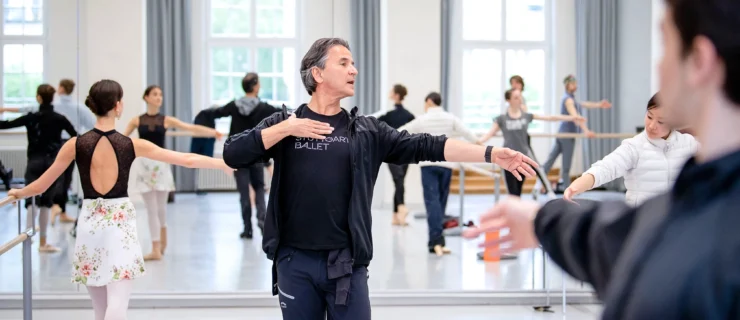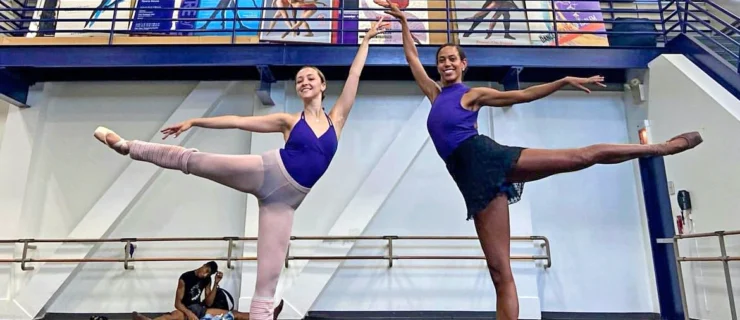Contemporary Lessons
Maria Kowroski
As a 13-year-old ballet student in Michigan, Maria Kowroski was surprised to be cast in a jazz work set to Nine Inch Nails for a school show. “I liked that I wasn’t labeled a ballet dancer,” she remembers, “and that someone took a chance and used me in that way.” Choreographers have continued to take chances on Kowroski, now a New York City Ballet principal, with electrifying results. She’s worked with dancemakers such as Susan Stroman, Mauro Bigonzetti, Jorma Elo, Christopher Wheeldon and Alexei Ratmansky. Italian choreographer Bigonzetti has created three ballets on Kowroski and holds a special place in her heart.
“He’s pulled something out of me like no one else has,” she says. “It’s exciting to see yourself doing something that you never thought you could, throwing yourself around and sometimes feeling like an idiot but also letting loose and feeling alive from head to toe.”
The experience inspired Kowroski to cultivate the sense of abandon she felt performing Bigonzetti’s work into the classical ballets she performs. “Sometimes onstage I was worried about missing a turn or balance, thinking about what could go wrong instead of being in each moment. After In Vento—feeling the electricity and being in the moment so intensely—I wanted to take that to every ballet.”
Not all contemporary works have come easily to Kowroski. When Elo created Slice to Sharp, Kowroski had mononucleosis and missed out on the creation process, which meant that she had to learn the role later from videotapes. “It was very hard for me,” she says. “I was trying to understand his movement and style, and it didn’t come naturally.” When the piece was revived, she was able to rehearse more with Elo. “Then it became so clear,” she says. “He explained it and changed steps to make it more organic for me.”
Kowroski urges even the most serious ballet students and professionals to keep an open mind. “Maybe your passion has always been ballet,” she says. “You still might find when you start moving in a different way that it feels nice. Your body is your instrument, and it’s amazing what you can do with it.”
Noelani Pantastico
When Noelani Pantastico was a brand-new corps dancer at Pacific Northwest Ballet, choreographer Dominique Dumais auditioned the dancers by asking them to improvise across the floor. Pantastico, then 17, looked so uncomfortable that Dumais took pity on her and excused her from the audition. Entranced by the classics, Pantastico once told an interviewer that she’d be happy dancing only story ballets her entire career.
A decade later, Pantastico, a former principal at PNB now headed for Les Ballets de Monte-Carlo, excels in classical and contemporary choreography and credits the latter for enhancing her career. She has performed works by Mark Morris, David Parsons, William Forsythe, Ulysses Dove, Victor Quijada, Paul Gibson, Kevin O’Day and Jean-Christophe Maillot.
Her transformation from confirmed bunhead to multifaceted performer was gradual. A few years after that first audition with Dumais, the choreographer cast Pantastico in her Time and Other Matter. This time she was more open. “I had a session with [Dumais] alone, where she just said, ‘Keep going,’” remembers Pantastico. “Thank God there weren’t other dancers there, because I don’t know if I could have done it. I was doing some crazy stuff, but she made me realize that it was OK. And when I watched [the video], I liked it.”
Like many classically trained dancers, Pantastico had to learn to ignore the instinct to make every position pretty and concentrate on inhabiting movement that occasionally felt awkward. “With Victor [Quijada], it was like turning another page in the book,” she says, “discovering a new way of moving: turning in, using my elbow to draw something.”
Dancing plotless contemporary works subtly altered her outlook, challenging her to take an increasingly thoughtful approach to performance. “It’s easy to follow a story line and become someone in a piece, but with contemporary work, you have to make something of it,” she says. “You have to be completely present. It’s important not to be embarrassed to improvise or to do something out of your comfort zone. That’s a hard step when you’re thinking, ‘Everyone is looking at me doing this weird stuff.’ Even I have a hard time with that. But it’s for the art form, and it only makes dancers better.”
Marcelo Gomes
A dashing Prince Siegfried, romantic Romeo and elegant Albrecht, Marcelo Gomes is completely at home in the classics. As a principal at American Ballet Theatre, he has become known for his moving portrayals of the great leading men. Yet equally important to him has been the opportunity to dance in contemporary works; he says that experience has played a fundamental role in shaping the dancer he has become. “So many different choreographers inspire me in different ways,” he says. “Lar Lubovitch, Twyla Tharp, Mark Morris and Jorma Elo have all pushed me to a level that I’ve never been to before. When you are working with different choreographers you have to think outside the box. It’s wonderful for an artist to do that.”
Gomes’s appreciation for contemporary work was acquired through experience. “When I joined the corps, I was 17. I watched people in the studio dancing to strange music and moving their bodies in different ways, and I remember thinking I didn’t know if I could ever see myself doing that,” he says. “Now I don’t think I could live without it.”
He got his feet wet in Jirí Kylián’s Sinfonietta. “When I was in the studio and given the steps, I thought, ‘How interesting, my body can do this,’” he says. More contemporary and even modern dance works followed, including Martha Graham’s Diversion of Angels. “You develop by educating your body on all these forms and techniques,” he says, “and you apply them. The more experience I got, the more comfortable I was working with a choreographer.”
Gomes credits his classical technique and training for laying an essential foundation for artistic exploration. “As far as pure muscle strength goes, classical ballet gives you a certain kind of stretch that is very different from the one that you use for contemporary ballet. And yet you have to forget a lot about classical ballet in contemporary works. You can’t be afraid of looking a certain way. That was the most challenging for me, because I was trained in ballet class to do pliés and tendus and jetés a certain way. And then suddenly I had to forget that and challenge my body with different muscles and shapes.”
Sofiane Sylve
For Sofiane Sylve, who grew up in France and has danced in companies in Germany, the Netherlands, New York and San Francisco, balancing classical and contemporary repertoires was never difficult. Currently a guest artist with San Francisco Ballet, Sylve has worked with choreographers Jorma Elo, William Forsythe, David Dawson, Christopher Wheeldon, Alexei Ratmansky and Hans van Manen.
Equally as fascinated by the challenges of dancing Giselle as Wayne McGregor’s contemporary Eden/Eden, both of which she danced this spring with SFB, Sylve considers classical and contemporary ballet beautifully different segments of ballet in the 21st century. “Once you’ve done the classical ballets you have to experience different colors of the palate,” she says. “It’s primary as an artist to experience different things. The body is such a fantastic machine that it’s almost a shame if you don’t see how far you can go.”
Sylve has found the most challenging aspects of dancing contemporary work to be developing a sense of weightedness in pointe shoes, adjusting her body placement accordingly and embracing positions that feel awkward. “You appear very light and tall and all of a sudden, they want you down and on the floor and being weird. It’s a very different effect,” she says. “It’s been fun and painful because you put your body in positions you would have never thought of. And then try to get out of that and continue with the music.”
She credits her success in contemporary works to her classical training, adding that they have even deepened her understanding of classical technique.
“Classical ballet is the hardest thing, period. Once you know you can do that, then you’ve got to experience other things,” says Sylve. “I think that by dancing contemporary works you can learn the rules of classical ballet again because you can extend yourself so far away from it. When you can go back to it, things make a little bit more sense.”
She’d like to have a chance to work with Mark Morris, John Neumeier and Jirí Kylián, as well as tackle some more Kenneth MacMillan ballets. “It is important to have a varied rep in terms of getting to know that there are so many colors out there,” she says. “Then, if you want to paint in white then you paint in white, but at least you know you have a range of colors you can use.”
Caitlin Sims is a freelance writer based in San Francisco.





